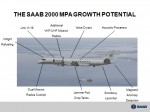Swedish defense and aerospace company SAAB is planning to offer its SAAB 2000 aircraft to the Indian Navy when it issues a Request For Proposal (RFP) for Medium Range Maritime Reconnaissance (MRMR) aircraft in the next few months. The Indian Navy currently operates the Russian Tu-142 Bear and IL-38 aircraft, in addition to Dornier aircraft. It has also ordered eight P-8I Long Range Maritime Reconnaissance (LRMR) aircraft and is expected to buy an additional four.
The aircraft is built by US aviation company Boeing, which is planning to pitch a medium range ‘diet’ P-8 for the Indian Navy’s MRMR tender.
While the SAAB 2000 is being offered with the RBS-15 Anti Ship Missile and a fifth generation Selex AESA radar, what is also interesting is that SAAB is offering re-manufactured aircraft, since the company ceased production of the aircraft in 1999.
“We will take an existing SAAB 2000. We will re-manufacture it and build it up. So it will be ground zero flying hours. We will have all the warranties. We will have 35,000 flying hours. It will have 25 years of support,” said Tommy Hultin, SAAB’s Business Development Director for the program.
Hultin also says the Harpoon missile manufactured by Boeing, which India is already planning to acquire for the Indian Air Force (IAF) Jaguar and the P-8I aircraft, can also be configured on the SAAB 2000, which he points out, is one of the fastest turboprop aircraft flying.
SAAB's offer

The baseline SAAB 2000
Radar: Selex Active Electronically Scanned Array (AESA) Maritime Surveillance Radar with long range search of 200 nautical miles. The interrogator functions of the Identification Friend-or-Foe (IFF) capability can be customized. The radar is paired with a Saab R4A AIS transponder receiver/transmitter system that marks maritime activity with an encrypted data link.
Electro-Optic (HDTV) and Thermal Imager sensors: For close range detection, identification and recording of surface objects and activities.

Growth options on the SAAB 2000
ELINT: Capable of intercepting and collect intelligence information consisting of detailed information of e.g. complex emitters active signal components, the relationship and the dynamics between active signal components.
ESM system: Automatically identifies RF (Radio Frequency) signal sources and Direction Finding of RF signal sources.

Specifications of the SAAB 2000
SPS system: Radar warning receivers, missile approach warning sensors, laser warning sensors as well as chaff and flare dispensers for self protection.
COMINT system: Enhances SIGINT capability by complementing the baseline ELINT system. Includes Direction Finder function and an Intercept System.

Cabin layout of the SAAB 2000
Command & Control (C2) system: Integrates and assists in controlling mission sensors and provides the user interface to mission operators, via four (4) workstations installed side-by-side in the cabin facing starboard, and to the pilots via a dedicated tactical display. The workstations also provide access to the mission communication system.
FLIR: Forward Looking Infra Red which can be used for identification of vessels. While performance depends on on environmental conditions such as fog, sea-state, salt percentage, it can typically be used within a range of 5-10 nautical miles.
SAAB says the aircraft can operate from high altitude airfields, ‘taking off with maximum load and fuel even at very hot temperatures’. With a cruising speed of 350 knots, it can climb to an altitude of 20,000 ft in 10 minutes and reach an operating area 1,000 nautical miles away within three hours. It can maintain position on a single engine even at a height of 20,000 feet.
The aircraft is said to be able to carry out a mission covering 200 nautical miles Exclusive Economic Zone (EEZ) for 5.5 hours at an altitude of 2,000 ft, or longer patrol times at higher altitudes up to 31000 feet.




